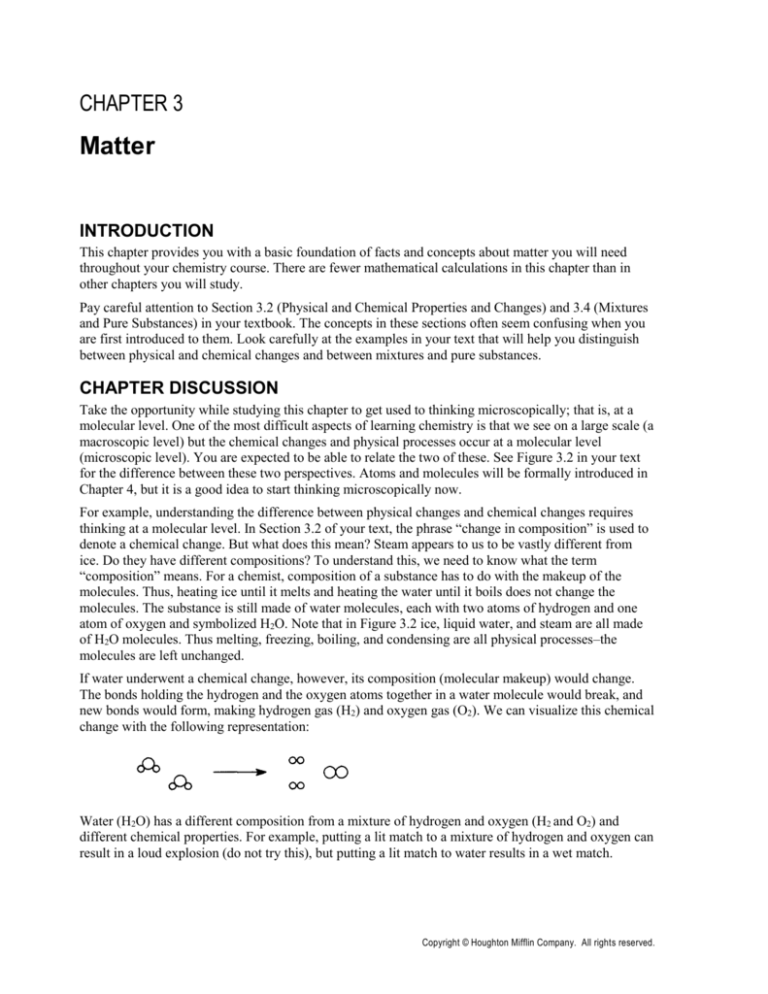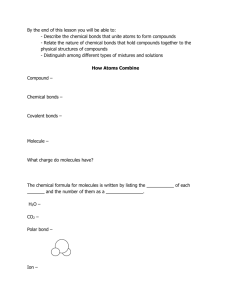
CHAPTER 3
Matter
INTRODUCTION
This chapter provides you with a basic foundation of facts and concepts about matter you will need
throughout your chemistry course. There are fewer mathematical calculations in this chapter than in
other chapters you will study.
Pay careful attention to Section 3.2 (Physical and Chemical Properties and Changes) and 3.4 (Mixtures
and Pure Substances) in your textbook. The concepts in these sections often seem confusing when you
are first introduced to them. Look carefully at the examples in your text that will help you distinguish
between physical and chemical changes and between mixtures and pure substances.
CHAPTER DISCUSSION
Take the opportunity while studying this chapter to get used to thinking microscopically; that is, at a
molecular level. One of the most difficult aspects of learning chemistry is that we see on a large scale (a
macroscopic level) but the chemical changes and physical processes occur at a molecular level
(microscopic level). You are expected to be able to relate the two of these. See Figure 3.2 in your text
for the difference between these two perspectives. Atoms and molecules will be formally introduced in
Chapter 4, but it is a good idea to start thinking microscopically now.
For example, understanding the difference between physical changes and chemical changes requires
thinking at a molecular level. In Section 3.2 of your text, the phrase “change in composition” is used to
denote a chemical change. But what does this mean? Steam appears to us to be vastly different from
ice. Do they have different compositions? To understand this, we need to know what the term
“composition” means. For a chemist, composition of a substance has to do with the makeup of the
molecules. Thus, heating ice until it melts and heating the water until it boils does not change the
molecules. The substance is still made of water molecules, each with two atoms of hydrogen and one
atom of oxygen and symbolized H2O. Note that in Figure 3.2 ice, liquid water, and steam are all made
of H2O molecules. Thus melting, freezing, boiling, and condensing are all physical processes–the
molecules are left unchanged.
If water underwent a chemical change, however, its composition (molecular makeup) would change.
The bonds holding the hydrogen and the oxygen atoms together in a water molecule would break, and
new bonds would form, making hydrogen gas (H2) and oxygen gas (O2). We can visualize this chemical
change with the following representation:
Water (H2O) has a different composition from a mixture of hydrogen and oxygen (H2 and O2) and
different chemical properties. For example, putting a lit match to a mixture of hydrogen and oxygen can
result in a loud explosion (do not try this), but putting a lit match to water results in a wet match.
Copyright © Houghton Mifflin Company. All rights reserved.
Chapter 3: Matter
21
Therefore, making sense of chemical and physical changes is difficult without a molecular perspective.
The same is true with the concepts of elements, mixtures, and compounds. Don’t merely memorize the
text definitions for these, but instead understand the differences among each of these (including
heterogeneous and homogeneous mixtures). One of the best ways to achieve this understanding is to
make sketches of these at a molecular level.
For example, answer the following questions (think about these before reading on).
1.
Which best represents a homogeneous mixture of an element and a compound?
2.
Which best represents a gaseous compound?
3.
Which best represents a solid element?
4.
Which best represents a heterogeneous mixture of two elements?
5.
What would you term the choice not chosen in 1-4?
The answers are “e,” “c,” “b,” “d” and “a gaseous element.” Notice that a compound differs from an
element in that a compound is made of at least two different types of atoms.
You should be able to draw molecular-level sketches of any possible combinations of elements,
compounds, mixtures (homogeneous and heterogeneous), gases, liquids, and solids. For example,
sketch a homogeneous mixture of a gaseous element in a liquid compound.
You also should be able to answer the following questions:
1.
What is wrong with the term “heterogeneous compound”? “Homogeneous compound”?
2.
Sketch molecular-level diagrams to make sense of Figure 3.9 and Figure 3.10.
LEARNING REVIEW
1.
Which of the properties below is/are physical properties, and which is/are chemical properties?
a.
Oxygen atoms can combine with hydrogen atoms to form water molecules.
b.
Ethyl alcohol boils at 78°C.
c.
Liquid oxygen is pale blue in color.
Copyright © Houghton Mifflin Company. All rights reserved.
22
2.
3.
4.
5.
6.
Chapter 3: Matter
Which of the changes below are physical changes, and which are chemical changes?
a.
A copper strip is hammered flat to make a bracelet.
b.
Copper and sulfur react to form a new substance, copper(I) sulfide.
c.
Liquid water freezes at 273 K.
d.
Oxygen gas condenses to a liquid at −183°C.
e.
You prepare a 3-minute egg for breakfast.
Which of the symbols below represent elements, and which represent compounds?
a.
S
b.
H2O
c.
C
d.
N2O5
e.
NaOH
Is each of the properties below a physical or a chemical property?
a.
temperature at which a solid is converted to a liquid
b.
odor
c.
temperature at which a compound breaks down into its elements
d.
oxygen reacts with a substance to produce energy
Which of the substances below are mixtures, and which are pure substances?
a.
gasoline
b.
table sugar (sucrose)
c.
garden soil
d.
sterling-silver necklace
Which of the mixtures is homogeneous and which is heterogeneous?
a.
sweetened hot tea
b.
plastic bag filled with leaves and grass clippings
c.
a weak solution of rubbing alcohol in water
d.
devil’s food cake mix
7.
Describe how you can separate a mixture by filtration.
8.
What type of mixture is best separated by filtration, a homogeneous mixture or a heterogeneous
mixture?
9.
Describe how you would separate the following mixtures.
a.
sand from gravel
b.
salt from sand
c.
sugar from water
Copyright © Houghton Mifflin Company. All rights reserved.
Chapter 3: Matter
23
10. Label each part of the distillation apparatus below.
ANSWERS TO LEARNING REVIEW
1.
a.
Oxygen can combine with hydrogen to produce a new substance, water. Because oxygen and
hydrogen have the potential to combine to form a new substance, this is an example of a
chemical property.
b.
Observing ethyl alcohol boiling does not destroy or change the ethyl alcohol molecules.
Therefore boiling point is a physical property.
c.
Observing the color of a substance does not change its composition. The pale blue color of
liquid oxygen is a physical property.
a.
When a copper strip is hammered into a bracelet, the shape of the copper is changed, but not
the composition. This is a physical change.
b.
The new substance, copper sulfide, is a black solid that does not have any of the
characteristics of copper metal or yellow elemental sulfur. This is a chemical change.
c.
When liquid water freezes to become solid ice, the molecules are still those of water. No
change in composition has occurred. This is a physical change.
d.
Liquid oxygen molecules become solid oxygen molecules at −183°C. This is a physical
change.
e.
Cooking an egg causes changes to the egg’s composition. Heating changes the structure of
large egg proteins, causing them to form solids. This is a chemical change.
2.
Copyright © Houghton Mifflin Company. All rights reserved.
24
Chapter 3: Matter
3.
a.
S is the symbol for the element sulfur.
b.
H2O has two kinds of atoms, O and H. It is a compound.
c.
C is the symbol for the element carbon.
d.
N2O5 has two kinds of atoms, N and O. It is a compound.
e.
NaOH has three kinds of atoms, Na, O and H. It is a compound.
a.
Physical property, because a melted substance has the same composition as a solid
substance.
b.
Physical property, because observing the odor of a substance does not change the
composition of the substance.
c.
Chemical property, because the temperature that causes a substance to break down into
elements causes destruction of the substance.
d.
Chemical property, because oxygen reacting with a substance describes a chemical change
occurring.
a.
Gasoline is a mixture of complex carbon-containing molecules, detergents, and additives.
b.
Table sugar is a pure substance. It contains only sucrose molecules.
c.
Garden soil is a mixture. It contains sand, water, clay, dead plant leaves, and other
components.
d.
Sterling silver is made from 93% silver and 7% copper by mass. It is a mixture.
a.
Sweetened tea is a homogeneous mixture. When sugar is added to hot tea, it dissolves. All of
the tea is equally sweetened.
b.
A bag full of leaves and grass clippings is a heterogeneous mixture. Some parts of the bag
will contain more leaves than grass, and other parts will contain more grass than leaves.
c.
Rubbing alcohol and water mix freely with each other. The molecules of one completely
disperse in molecules of the other. This produces a homogeneous solution.
d.
A devil’s food cake mix is a homogeneous mixture. There are no lumps (usually) of sugar,
or clumps of flour. All the ingredients are distributed equally throughout the mix.
4.
5.
6.
7.
Separating mixtures by filtration depends upon differences in the physical properties of the
components of the mixture. Pour the mixture onto a mesh. One common mesh is filter paper,
which is made from a mesh of cellulose fibers. The liquid in the mixture can pass through the
cellulose fibers into a container below. The particles remain behind, trapped in the fibers of the
mesh.
8.
Filtration can separate a heterogeneous mixture that contains a liquid and a solid component.
Copyright © Houghton Mifflin Company. All rights reserved.
Chapter 3: Matter
25
9.
a.
Sand and gravel can be separated by filtration. Use a mesh that allows the sand particles to
pass through but retains the gravel, for example, a piece of wire screen.
b.
A salt and sand mixture can be separated by adding water and filtering. The salt will dissolve
in the water, while the sand will not. By filtering the sand and salt water mixture, the pure
sand remains behind while the salt passes through the mesh with the water.
c.
Sugar and water cannot be separated by filtration because the sugar molecules dissolve in
the water and will pass through a mesh. They can, however, be separated by distillation.
Heat the mixture until the water boils (at 100 °C) and is converted to steam. The sugar has a
higher boiling point than water does and is not vaporized. The steam rises in the distillation
apparatus and can be captured and recondensed to liquid water. The sugar remains behind in
the distillation flask.
10.
Copyright © Houghton Mifflin Company. All rights reserved.








